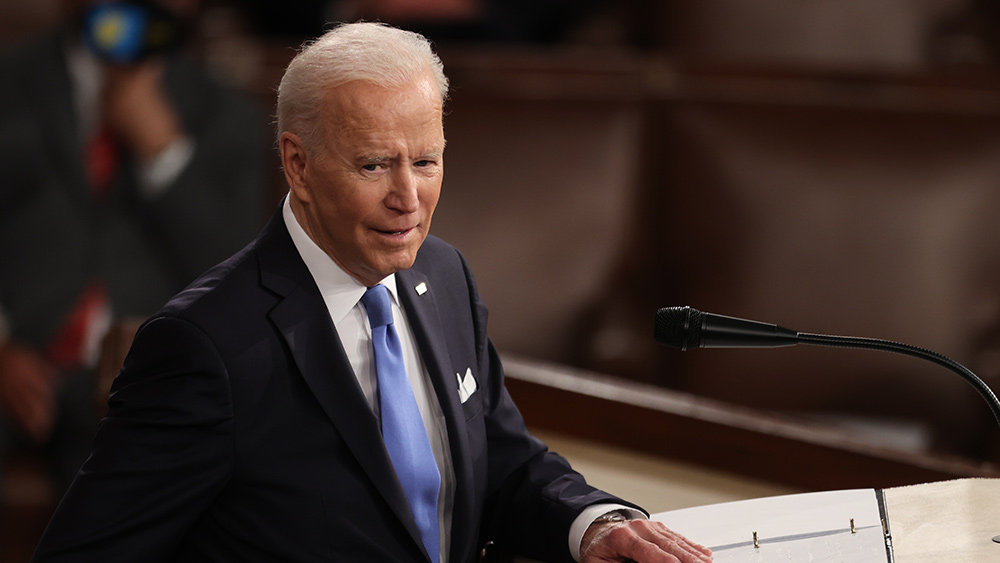Settling wreckage from the past
05/17/2022 / By News Editors

Settling wreckage from the past with realities of the present can be difficult and painful. If you do the crime. You must do the time.
(Article by MN Gordon republished from EconomicPrism.com)
When it comes to financial markets and the economy, this can take many forms. Some of the most common include bankruptcy, shuttered businesses, and collapsing share prices.
This week Federal Reserve Chair Jay Powell and his cohorts at the Federal Open Market Committee Meeting (FOMC) raised the federal funds rate 50 basis points. This marked the first 50 basis point rate hike since 2000. It is part of the Fed’s initial efforts to settle up on wreckage from the past.
The world has changed markedly over the last 22 years. Certainly, the economy and financial markets have become twisted and warped. Without the proper perspective everything from the price of a gallon of gas to the price of a house is muddled and confused.
The main culprit, no doubt, is quantitative easing (QE) and zero interest rate policy (ZIRP) employed by the Fed. The troubles financial markets and the economy are now facing are the direct result of decades of Fed market intervention. The main purpose of these interventions has been to artificially suppress interest rates.
Ultra-low interest rates have the effect of robbing from the future. They pull consumption forward and mask business failures. They also reward risk takers while hurting savers.
After expanding its balance sheet by over $8 trillion over the last 14 years the Fed has produced raging consumer price inflation. The official inflation rate, as measured by the consumer price index, is now increasing at an annual rate of 8.5 percent – a 40 year high. The unofficial inflation rate is likely over 17 percent.
Wage earners, savers, retirees on fixed incomes, and generally everyone except the most upper crust are getting ravaged. The inflation tax is draining their savings, depressing their real wages, and reducing their standard of living.
What gives?
Hiking Rates in the Face of a Recession
The Fed, using backwards looking data, kept interest rates too low for too long. The consequences are nothing short of disastrous.
Financial assets, like stocks, bonds, and real estate, were simultaneously inflated to mega bubbles. This rewarded wealthy asset holders.
But what goes up must come down. Do the crime. Do the time. The reckoning of financial assets has only just begun.
For example, the S&P 500 is off to its worst start in 83 years. Over the first four months of 2022 the S&P 500 is down 13.7 percent. As context, the S&P 500 started the year down 17.3 percent in 1939 and 28.2 percent in 1932. Year to date the NASDAQ is down roughly 20 percent, losing 13 percent in April alone.
At the same time, U.S. gross domestic product (GDP) shrank by 1.4 percent during the first-quarter of 2022. The economy is contracting and may already be in a recession. We won’t officially know until second-quarter GDP data is reported, as a recession is generally considered a decline in GDP over two consecutive quarters.
In the interim, the massive stock, bond, and real estate bubbles that the Fed puffed up have a long way to fall. The stock market’s grinding its way into a bear market.
More importantly, the 10-Year Treasury yield has doubled to roughly 3 percent over the last 6-months. And the real estate market appears to be cracking.
Normally, a bear market and a recession come towards the end of an interest rate hiking cycle; not the beginning. But because the Fed held interest rates too low for too long, and took a blow torch to consumer prices, it now must hike rates in the face of a declining stock market and contracting economy.
And this is where things really get interesting…
Settling Wreckage from the Past
Because the Fed didn’t realize it was stimulating consumer price inflation until it was completely out of control, it has a giant mess on its hands. And, at this point, it doesn’t appear to have the fortitude to clean things up.
You see, the Fed is deeply behind the curve. It has a lot of catching up to do. This means it will have to hike rates much higher than most people are expecting – even as the economy and financial markets are in full meltdown.
When considering Fed policy it is not enough to consider just the federal funds rate. Inflation must also be considered in relation to the federal funds rate. If inflation and the rate of inflation is higher and rising faster than interest rates, Fed policy is still inflationary.
In March, the Fed increased the federal funds rate by 0.25 percent. This week it hiked the federal funds rate another 0.5 percent, bring it to a target range of 0.75 to 1 percent. Yet, in March alone, the CPI increased 1.2 percent (April CPI will be released next week).
So while the Fed has hiked interest rates 0.75 percent since March it is still falling behind the inflation rate curve. It’s an ugly place to be. And will only get uglier, as the economy stagnates and inflation intensifies.
If the Fed was really serious about fighting inflation it would have hiked interest rates this week by at least 1.5 percent. Yet it didn’t. Thus Wall Street celebrated with the S&P 500 and NASDAQ both jumping 3 percent following the FOMC statement on Wednesday.
Alas, this stock market ecstasy was brief. On Thursday the S&P 500 fell 3.5 percent and the NASDAQ dropped nearly 5 percent.
The idea that the Fed can contain inflation without provoking a recession is a fantasy. The crimes committed are too substantial.
One way or another, wreckage from the past must be settled up. And get this: You’re the collateral.
Sincerely,
MN Gordon
for Economic Prism
Read more at: EconomicPrism.com
Submit a correction >>
Tagged Under:
big government, bubble, chaos, collapse, consumer prices, debt bomb, debt collapse, economic crash, economy, Federal Reserve, finance, FOMC, GDP, inflation, market crash, money supply, recession, risk
This article may contain statements that reflect the opinion of the author
RECENT NEWS & ARTICLES
COPYRIGHT © 2020 Debtbomb.news
All content posted on this site is protected under Free Speech. Debtbomb.news is not responsible for content written by contributing authors. The information on this site is provided for educational and entertainment purposes only. It is not intended as a substitute for professional advice of any kind. Debtbomb.news assumes no responsibility for the use or misuse of this material. All trademarks, registered trademarks and service marks mentioned on this site are the property of their respective owners.




















